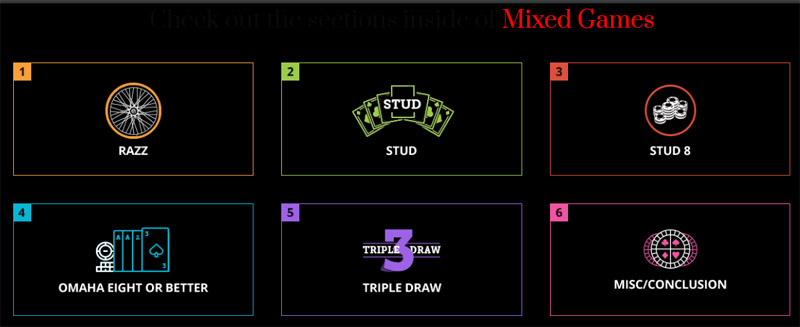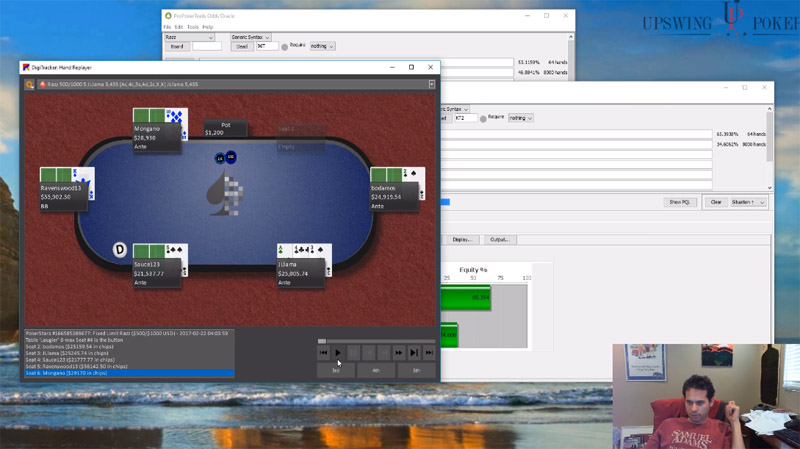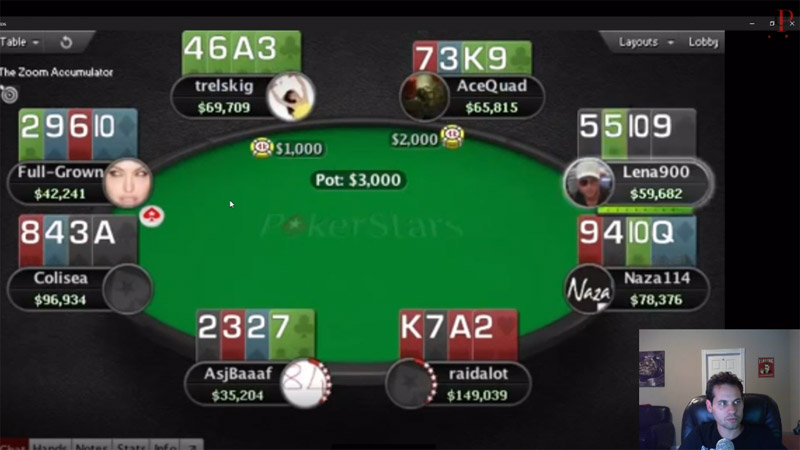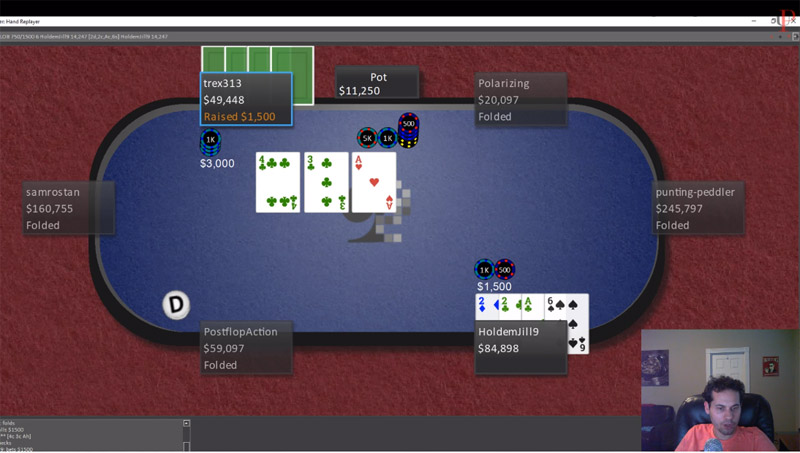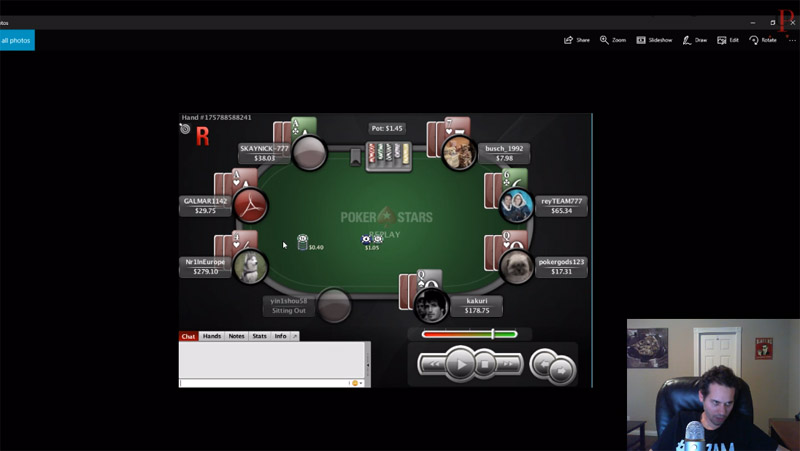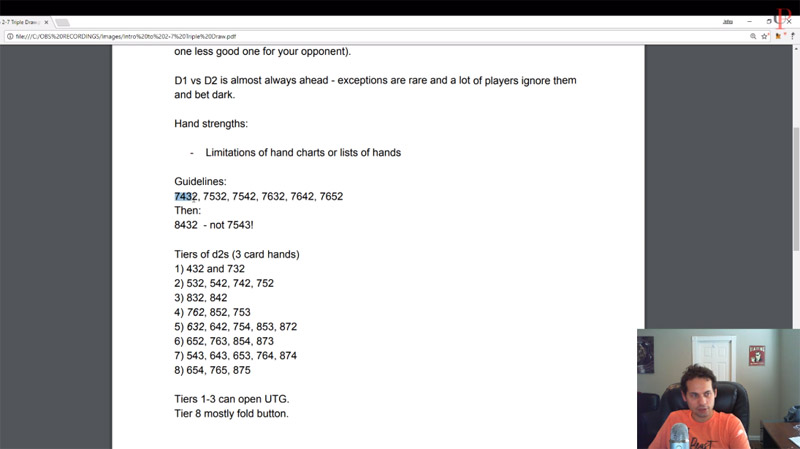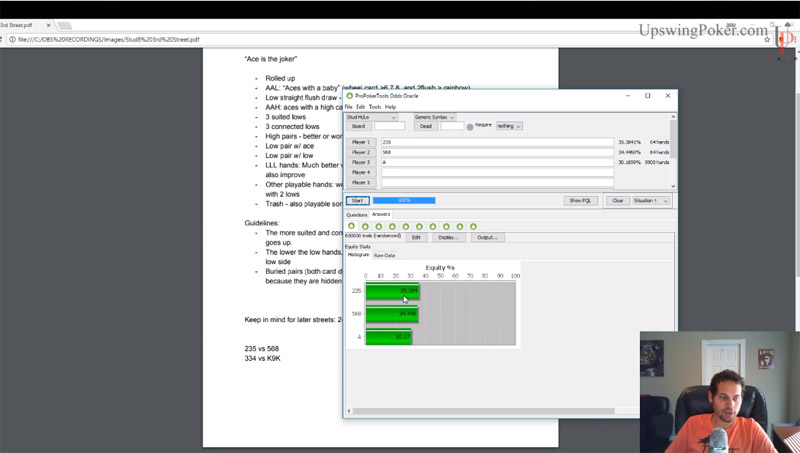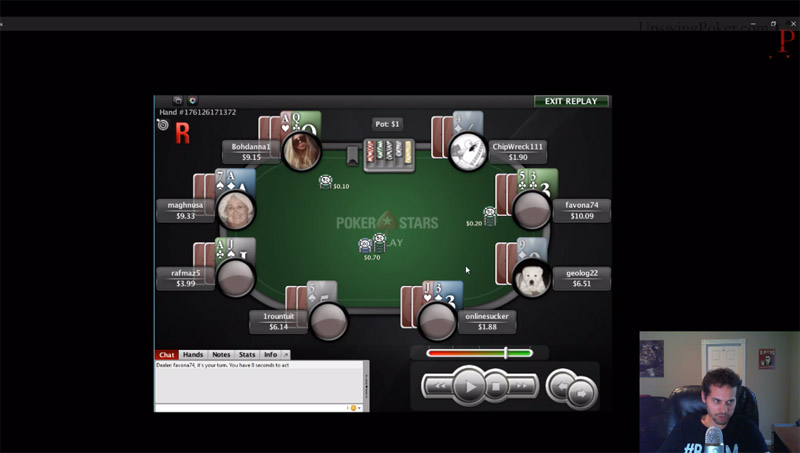Although games such as No Limit Hold’em and Pot Limit Omaha are by far the most popular with the players there are many more poker variations out there. Some of these are frequently played on their own, some are usually found in the 8-game mix or H.O.R.S.E games and learning how to play them well can be quite beneficial.
If you feel the drive to become better at mixed games or there is a particular game variation that you’re interested in, Upswings Mixed Games Mastery Course is an excellent place to start.
Presented by Jake “HoldemJill9” Abdalla, the course covers five arguably lesser-known games from the 8-game mix, namely Stud and Stud 8, Omaha 8, Razz, and Deuce to Seven Triple Draw. Each of the games is given its own module so you don’t have to watch the whole course if you don’t feel the need and you can go about learning games in any way or order you prefer.
Table Of Contents
- Mixed Games Mastery Course at a Glance
- Learning Razz One Street at a Time
- Omaha 8: All You Need to Know
- Regular Seven Card Stud (Stud Hi)
- 2-7 Triple Draw: Unlike the Rest
- Stud Hi-Lo: Fighting for Two Sides of the Pot
- Final Words of Wisdom
- Alternatives to Jake “HoldemJill9” Abdalla
- Summary: Who Is Mixed Games Mastery For?
Mixed Games Mastery Course at a Glance
For his Mixed Game Mastery course, Abdalla has taken an approach that speaks equally to experienced players and those just starting their journey with a new variation. Each segment of the course begins with basics, like rules, betting, etc., and then gradually moves towards more advanced concepts.
Of course, if you already know how to play a particular variation and don’t need basic rules of Stud explained, for example, you can skip on introductory videos in each module. These videos are fairly short though, around 10 minutes each, so it’s not like they’ll take up a lot of your time either way.
This course is fairly extensive as Abdalla provides a very good overview of all five games, offering much more than basic strategies. Even very experienced players will find plenty of quality advice on how to improve their game in certain areas and how to go about fixing leaks in their gameplay.
One thing that Jake warns about before diving into the meat of the course is that these games are quite a bit different as they’re played in a limit format and only one of them is a flop game (O8). So, constructing your starting ranges and understanding equities is not always as simple or as straightforward if you are coming from a Hold'em or Omaha background.
Some general adjustments for mixed games include seeing more showdowns, bluffing less, and finding more spots for thin value bets. The ability to think on your feet and become good at approximation is a key to becoming successful in these games so the course in general aims to teach these principles and ideas.
Learning Razz One Street at a Time
Razz may not be a hugely popular variation on its own but for those looking to play any form of mixed games, it’s an important one to learn. The module covers everything, starting with the introduction to the game and explanation of the basic rules for those who may be completely new to it.
After the introduction, Abdalla continues to gradually explain the Razz strategy, with a lot of focus being on the third street, i.e. the first betting round.
In these videos, you’ll learn how to recognize good starting hands and understand some of the most important equities you’ll need to know moving forward. Jake also touches upon some positional concepts and pot odds, which will dictate your play in many spots (completing instead of raising to leave yourself more room to fold on unfavorable cards later on, for example).
These videos also bring charts with equities for different hand types and how these hands stack up against each other. Abdalla also emphasizes the importance of the door card in Razz, as this is what will often let you put pressure on your opponents and / or prevent them from putting pressure on you.
Later videos deal with play on the 4th street and beyond, focusing on things such as the importance of releasing your hands in the spots where things are more defined based on the visible cards. It all wraps up with some actual hand examples from WCOOP and SCOOP tournaments.
No matter what your level of experience might be in Razz, this module has something to offer. Naturally, those who haven’t had the chance to study the game before will find more concepts that are new to them but even those who have been playing for a while will certainly be able to discover some fresh ideas they could apply to their games.
Omaha 8: All You Need to Know
Being a split hi-lo game, Omaha 8 is a fairly complex variation. Abdalla starts with explaining the rules and some of the most important concepts for those just learning the ropes but quickly moves on to the important stuff.
He leads in with the discussion on hand equities in O8 and how these run much closer together than in most other formats. This fact influences your strategy as you have less incentive to open many hands but have more reasons to call more frequently and play flops, especially when defending from the big blind.
To bring this point home, he presents several examples that are both interesting to watch and quite educational. Abdalla takes the time to really explains various spots and the logic behind theoretical ideas explained earlier.
After the preflop stuff, the course moves to the flop play. Once again, flop equities are often very close together, which complicates your decision making process. In the videos talking about flop play, you’ll find plenty of numbers and percentages that are probably too complicated to just learn by heart but will give you a good general idea of why certain approaches do and don’t work.
Final theoretical videos cover turn and river play. These lessons teach you about some of the common mistakes found with less experienced players, finding good spots to go for the value, and recognizing different river scenarios where you need to decide between check-calling and betting out for thin value.
If you had a chance to try Omaha Hi Lo before but couldn’t quite wrap your head around the game, the Mixed Games Mastery course by Uspwing Poker will get you there. It answers pretty much all important questions about the game and also brings some fine plays and strategies that can really take your game to the next level.
Regular Seven Card Stud (Stud Hi)
Stud is probably one of the better known games in this mix as it used to be quite popular before Hold’em took over. Because of this and because of the fact the game shares many similarities with Razz in terms of rules, Abdalla doesn’t spend too much time talking about basic rules.
He does, however, explains some basic terminology used in the game, which is a nice touch and definitely helps with keeping up with the rest of the content as knowing terms such as rolled, buried, and smoked bets is important for Stud players.
Like other modules, this one also takes the step-by-step approach, breaking things down by relevant betting streets. The main focus is on the third street, where Abdalla explains four main concepts to think about before entering a pot:
- Your hand strength
- How many higher cards are in the pot (ahead of you and after you)
- Card removal
- Opponents’ tendencies
After listing these points, he goes on to break down each of them, talking about how and why they’re key to your success in Seven Card Stud.
One very interesting discussion is the one that deals with the strength of cards on the table and how to utilize this information. Abdalla explains some numbers and percentages but emphasizes that these aren’t set in stone. Things change quite a bit depending on the player’s action. If they’re showing a high card like an Ace and a King and are also willing to build a big pot, it weighs their range much more towards strong holdings.
Knowing what your opponents’ tendencies are is also quite important. Depending on the game setup, you can adjust your starting ranges and decide if you want to get involved with more hands or tighten up and play only stronger hands looking for the max value when you do get them.
After providing some hand examples to bring these points home, Abdalla continues the module with the discussion of later Stud streets.
Like in all stud-type games, things change with each new street. As more information is revealed, hand ranges become much better defined. Going street by street, you’ll learn to find spots where folding is your best course of action as well as understanding how and when you can find value in spots that might not look favorable at the first glance.
2-7 Triple Draw: Unlike the Rest
The Mixed Games Mastery course module covering 2-7 Triple Draw is maybe the most interesting one in the whole series as this is the game that many players know nothing or very little about. It is also the only draw games in this course, which makes it completely different from the others.
Because of this, Abdalla takes more time to explain the rules of the game, betting mechanics, and everything else you need to know before you sit down to play. The introductory part covers all the important basics and will help clear any misconceptions you may have had about this variation.
After this, you’re given a lesson on how to choose your starting hands in 2-7 Triple Draws and there are even downloadable charts provided. However, Abdalla emphasizes that these charts are somewhat limited in their effectiveness.
Following videos explain things going one street at the time, breaking down many important concepts of the game. Having very little experience with 2-7 Triple Draw myself, I won’t try to go too much into what you’ll find inside but it suffices to say you’ll likely have a brand new outlook on the game after watching this module.
To wrap things up, there are many hand examples where you’ll get to see theoretical concepts applied in practice. This is always a good thing but particularly so with the game like 2-7 Triple Draw as this isn’t the game you get to see played every day.
Stud Hi-Lo: Fighting for Two Sides of the Pot
The fifth module in Upswing’s Mixed Game Mastery course discusses Seven Card Stud Hi-Lo or Stud 8, as it is often more referred to. If you’ve watched earlier modules, you’ll already have a pretty good idea of general rules so Abdalla doesn’t spend too much time on that topic.
A lot of time is given to starting hand considerations as this is one of the biggest issues inexperienced players have with the game. Recognizing what kind of hands play well in Stud 8 is very important and Abdalla does a great job of explaining the whole process of selection. You’ll learn what you need to pay attention to when picking your starting hands and why having certain cards in your hand is so valuable.
The rest of the module is about later streets and various concepts to improve your play, like:
- Multiway pots
- Heads up pots
- Equity realization, etc.
Stud 8 is definitely not the simplest poker variation out there as there is so much to pay attention to but I feel Jake has done a nice job of focusing on what’s really important. Watching this module and paying attention to what’s being explained is bound to make you a better Stud Hi-Lo player.
Final Words of Wisdom
The final section of the Mixed Games Mastery course contains some more hand examples and an interesting video that definitely provides a lot of value. In it, Abdalla provides a short breakdown of the entire course and offers some final tips for those looking to master mixed games.
In addition to suggesting some good software you’ll want to have handy, he is once again underlining the importance of studying and wanting to improve. Staying focused at the tables, keeping track of discarded cards, and taking notes on your opponents will help you a lot on that journey.
To wrap things up, Abdalla reiterates the idea that “perfect is the enemy of good”. You shouldn’t be striving to play the “perfect” game as that’s pretty much impossible. Rather, focus on trying different things, experimenting with various strategies, and learning as much as possible from these experiences. Your intuition and the power of analytical thinking are much more important than memorizing a bunch of charts in these games.
Alternatives to Jake “HoldemJill9” Abdalla
At HowToPlayPokerInfo, we have joined a a lot of training sites to find the best poker training on the market. Unfortunately, there aren't any alternatives to this course that we could find. So if you do want to learn to play Mixed game poker to the highest level, this is your only option besides “going it alone” with books.
Summary: Who Is Mixed Games Mastery For?
Of all Upswing courses, Mixed Games Mastery is perhaps the one that most “out there”. An average poker player is more than happy with Hold’em and maybe some Pot Limit Omaha and they aren’t looking to expand beyond that.
So, this course is definitely aimed at those players looking to take poker really seriously and learn new concepts from the different variations.
Mixed games are usually found at high stakes cash game tables (both online and live) and in some higher buy-in tournaments. You can still find some games at lower levels as well, of course, but the interest isn’t huge.
There is no doubt that Abdalla’s Mixed Games Mastery course is of the highest quality. Whether you’re looking to just learn one or two games from the mix well or are interested in all of them, this course will provide you with all the tools and knowledge you need to successfully compete at a fairly high level.
The only question is the value for money. For someone looking to grind low stakes mixed games in any way, this course is probably too expensive at $999. It is probably best fitted for relatively high stakes Hold’em and PLO players who have solid bankrolls and are looking to expand into new games. They can easily afford the purchase price and play at a level where this investment will be worth their while.
If you are ready to jump into this course and improve your mixed games, you can do so from here. Use coupon code Advanced50 to get $50 off.


